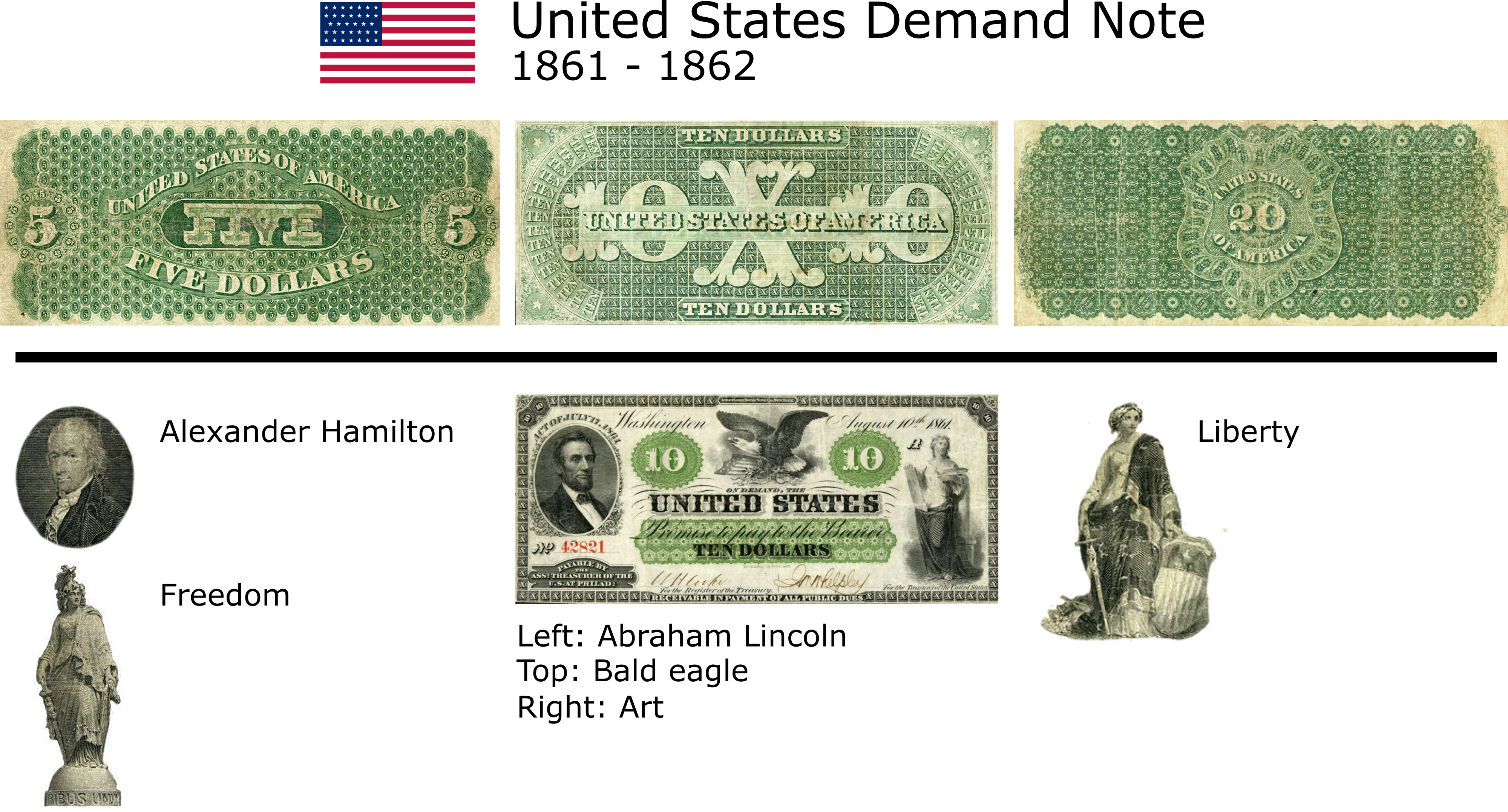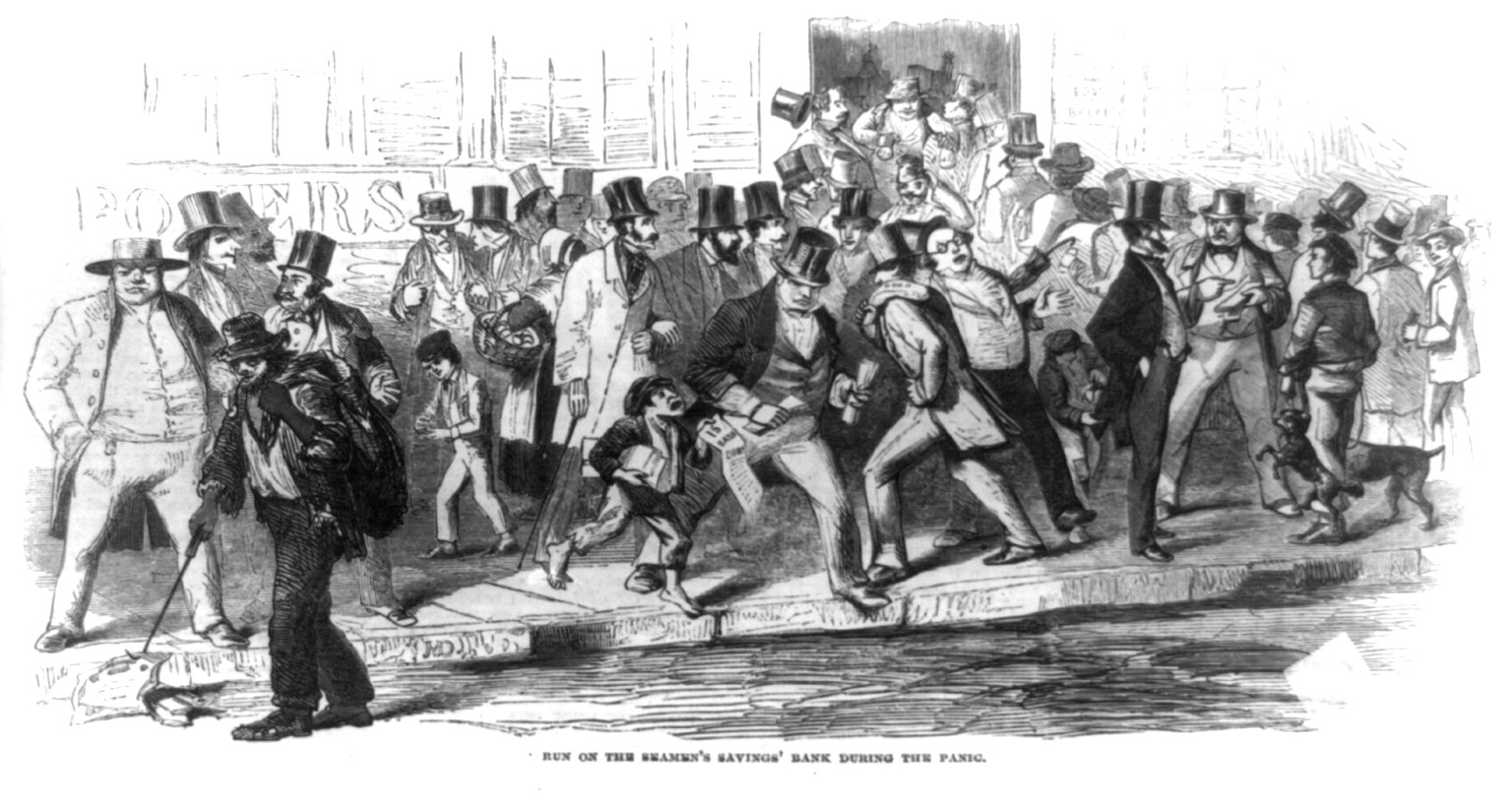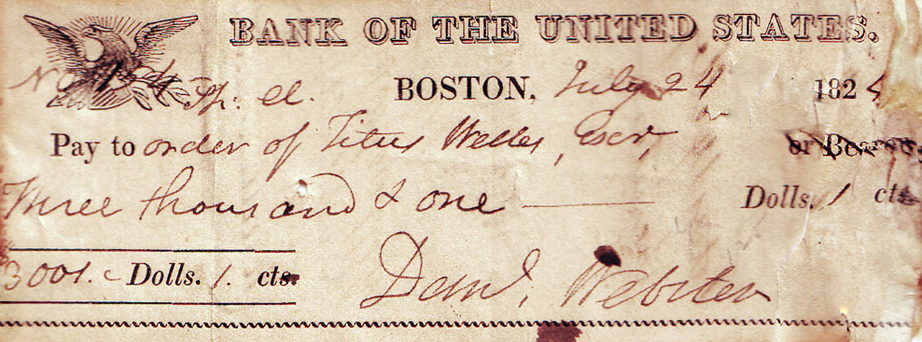|
Demand Note
A Demand Note is a type of United States paper money that was issued between August 1861 and April 1862 during the American Civil War in denominations of 5, 10, and 20 . Demand Notes were the first issue of paper money by the United States that achieved wide circulation and they are still in circulation today, though they are now extremely rare. The U.S. government placed the Demand Notes into circulation by using them to pay expenses incurred during the Civil War including the salaries of its workers and military personnel. Because of the distinctive green ink on their reverse, and because state-chartered bank and Confederate notes of the day typically had blank reverse, the Demand Notes were nicknamed "greenbacks", a name later inherited by United States Notes and Federal Reserve Notes. The obverse of the Demand Notes contained familiar elements such as the images of a bald eagle, Abraham Lincoln, and Alexander Hamilton, though the portraits used on Demand Notes are di ... [...More Info...] [...Related Items...] OR: [Wikipedia] [Google] [Baidu] |
Gresham's Law
In economics, Gresham's law is a monetary principle stating that "bad money drives out good". For example, if there are two forms of commodity money in circulation, which are accepted by law as having similar face value, the more valuable commodity will gradually disappear from circulation. The law was named in 1860 by economist Henry Dunning Macleod after Sir Thomas Gresham (1519–1579), an English financier during the Tudor dynasty. Gresham had urged Queen Elizabeth to restore confidence in then-debased English currency. The concept was thoroughly defined in medieval Europe by Nicolaus Copernicus and known centuries earlier in classical Antiquity, the Middle East and China. "Good money" and "bad money" Under Gresham's Law, "good money" is money that shows little difference between its nominal value (the face value of the coin) and its commodity value (the value of the metal of which it is made, often precious metals, nickel, or copper). In the absence of legal ... [...More Info...] [...Related Items...] OR: [Wikipedia] [Google] [Baidu] |
American Civil War
The American Civil War (April 12, 1861 – May 26, 1865; also known by other names) was a civil war in the United States. It was fought between the Union ("the North") and the Confederacy ("the South"), the latter formed by states that had seceded. The central cause of the war was the dispute over whether slavery would be permitted to expand into the western territories, leading to more slave states, or be prevented from doing so, which was widely believed would place slavery on a course of ultimate extinction. Decades of political controversy over slavery were brought to a head by the victory in the 1860 U.S. presidential election of Abraham Lincoln, who opposed slavery's expansion into the west. An initial seven southern slave states responded to Lincoln's victory by seceding from the United States and, in 1861, forming the Confederacy. The Confederacy seized U.S. forts and other federal assets within their borders. Led by Confederate President Jefferson ... [...More Info...] [...Related Items...] OR: [Wikipedia] [Google] [Baidu] |
Panic Of 1857
The Panic of 1857 was a financial panic in the United States caused by the declining international economy and over-expansion of the domestic economy. Because of the invention of the telegraph by Samuel F. Morse in 1844, the Panic of 1857 was the first financial crisis to spread rapidly throughout the United States. The world economy was also more interconnected by the 1850s, which also made the Panic of 1857 the first worldwide economic crisis. In Britain, the Palmerston government circumvented the requirements of the Bank Charter Act 1844, which required gold and silver reserves to back up the amount of money in circulation. Surfacing news of this circumvention set off the Panic in Britain. Beginning in September 1857, the financial downturn did not last long, but a proper recovery was not seen until the onset of the American Civil War in 1861. The sinking of contributed to the panic of 1857, as New York banks were awaiting a much-needed shipment of gold. American banks di ... [...More Info...] [...Related Items...] OR: [Wikipedia] [Google] [Baidu] |
John Joseph Lalor
John Joseph Lalor ( to 9 June 1899) was an American political scientist, a translator of work by Ludwig Nohl and Wilhelm Roscher, and the publisher of '' Cyclopaedia of Political Science, Political Economy, and the Political History of the United States'' (1895). Biography In 1885, Lalor taught at East Side High School, Milwaukee. Lalor worked as a translator in the Director of Mint, U. S. Treasury Department. Lalor collaborated with Louis Wolowski, Ludwig Nohl, and Paul Shorey. He translated works by Rudolf von Jhering and Wilhelm Roscher. He translated from German two works by Ludwig Nohl, a biography of Ludwig Beethoven Ludwig van Beethoven (baptised 17 December 177026 March 1827) was a German composer and pianist. Beethoven remains one of the most admired composers in the history of Western music; his works rank amongst the most performed of the classical ... in ''Life of Beethoven'' (1881) and Wolfgang Mozart in ''Life of Mozart'' (1880). In 1899, Lal ... [...More Info...] [...Related Items...] OR: [Wikipedia] [Google] [Baidu] |
War Of 1812
The War of 1812 (18 June 1812 – 17 February 1815) was fought by the United States of America and its indigenous allies against the United Kingdom and its allies in British North America, with limited participation by Spain in Florida. It began when the United States declared war on 18 June 1812 and, although peace terms were agreed upon in the December 1814 Treaty of Ghent, did not officially end until the peace treaty was ratified by Congress on 17 February 1815. Tensions originated in long-standing differences over territorial expansion in North America and British support for Native American tribes who opposed US colonial settlement in the Northwest Territory. These escalated in 1807 after the Royal Navy began enforcing tighter restrictions on American trade with France and press-ganged men they claimed as British subjects, even those with American citizenship certificates. Opinion in the US was split on how to respond, and although majorities in both the House an ... [...More Info...] [...Related Items...] OR: [Wikipedia] [Google] [Baidu] |
Second Bank Of The United States
The Second Bank of the United States was the second federally authorized Hamiltonian national bank in the United States. Located in Philadelphia, Pennsylvania, the bank was chartered from February 1816 to January 1836.. The Bank's formal name, according to section 9 of its charter as passed by Congress, was "The President Directors and Company of the Bank of the United States". While other banks in the US were chartered by and only allowed to have branches in a single state, it was authorized to have branches in multiple states and lend money to the US government. A private corporation with public duties, the Bank handled all fiscal transactions for the U.S. Government, and was accountable to Congress and the U.S. Treasury. Twenty percent of its capital was owned by the federal government, the Bank's single largest stockholder.. Four thousand private investors held 80 percent of the Bank's capital, including three thousand Europeans. The bulk of the stocks were held by a few ... [...More Info...] [...Related Items...] OR: [Wikipedia] [Google] [Baidu] |
First Bank Of The United States
First or 1st is the ordinal form of the number one (#1). First or 1st may also refer to: * World record, specifically the first instance of a particular achievement Arts and media Music * 1$T, American rapper, singer-songwriter, DJ, and record producer Albums * ''1st'' (album), a 1983 album by Streets * ''1st'' (Rasmus EP), a 1995 EP by The Rasmus, frequently identified as a single * ''1ST'', a 2021 album by SixTones * ''First'' (Baroness EP), an EP by Baroness * ''First'' (Ferlyn G EP), an EP by Ferlyn G * ''First'' (David Gates album), an album by David Gates * ''First'' (O'Bryan album), an album by O'Bryan * ''First'' (Raymond Lam album), an album by Raymond Lam * ''First'', an album by Denise Ho Songs * "First" (Cold War Kids song), a song by Cold War Kids * "First" (Lindsay Lohan song), a song by Lindsay Lohan * "First", a song by Everglow from '' Last Melody'' * "First", a song by Lauren Daigle * "First", a song by Niki & Gabi * "First", a song by Jonas Br ... [...More Info...] [...Related Items...] OR: [Wikipedia] [Google] [Baidu] |
Founding Fathers Of The United States
The Founding Fathers of the United States, known simply as the Founding Fathers or Founders, were a group of late-18th-century American revolutionary leaders who united the Thirteen Colonies, oversaw the war for independence from Great Britain, established the United States, and crafted a framework of government for the new nation. Historians generally recognize prominent leaders of the Revolutionary Era (1765–1791), such as George Washington, Benjamin Franklin, John Adams, Thomas Jefferson, and Alexander Hamilton, as Founding Fathers. In addition, signers of the Declaration of Independence and the U.S. Constitution are widely credited with the nation's founding, while other scholars include all delegates to the Constitutional Convention in 1787 whether they signed the Constitution or not. National Archives: Signers of the Declaration, Outline of signers National Archives, Framers of the Constitution Furthermore, some historians include signers of the Articles of Confed ... [...More Info...] [...Related Items...] OR: [Wikipedia] [Google] [Baidu] |
Spanish Dollar
The Spanish dollar, also known as the piece of eight ( es, Real de a ocho, , , or ), is a silver coin of approximately diameter worth eight Spanish reales. It was minted in the Spanish Empire following a monetary reform in 1497 with content 25.563 g = 0.822 oz t fine silver. It was widely used as the first international currency because of its uniformity in standard and milling characteristics. Some countries countermarked the Spanish dollar so it could be used as their local currency. Because the Spanish dollar was widely used in Europe, the Americas, and the Far East, it became the first world currency by the late 18th century. The Spanish dollar was the coin upon which the original United States dollar was based (at 0.7735 oz t = 24.0566 g), and it remained legal tender in the United States until the Coinage Act of 1857. Many other currencies around the world, such as the Japanese yen and the Chinese yuan, were initially based on the Spanish dollar and other 8-real c ... [...More Info...] [...Related Items...] OR: [Wikipedia] [Google] [Baidu] |
American Revolution
The American Revolution was an ideological and political revolution that occurred in British America between 1765 and 1791. The Americans in the Thirteen Colonies formed independent states that defeated the British in the American Revolutionary War (1775–1783), gaining independence from the British Crown and establishing the United States of America as the first nation-state founded on Enlightenment principles of liberal democracy. American colonists objected to being taxed by the Parliament of Great Britain, a body in which they had no direct representation. Before the 1760s, Britain's American colonies had enjoyed a high level of autonomy in their internal affairs, which were locally governed by colonial legislatures. During the 1760s, however, the British Parliament passed a number of acts that were intended to bring the American colonies under more direct rule from the British metropole and increasingly intertwine the economies of the colonies with those of Brit ... [...More Info...] [...Related Items...] OR: [Wikipedia] [Google] [Baidu] |
Continental Dollar
Early American currency went through several stages of development during the colonial and post-Revolutionary history of the United States. John Hull was authorized by the Massachusetts legislature to make the earliest coinage of the colony (the willow, the oak, and the pine tree shilling) in 1652. Because few coins were minted in the Thirteen Colonies, which later became the United Colonies and then the United States, foreign coins like the Spanish dollar were widely circulated. Colonial governments, at times, issued paper money to facilitate economic activities. The British Parliament passed Currency Acts in 1751, 1764, and 1773 to regulate colonial paper money. During the American Revolution, the Colonies became independent states. No longer subject to monetary regulations arbitrarily imposed by the British Parliament, the States began to issue paper money to pay for military expenses. The Continental Congress also issued paper money during the Revolution — known as Conti ... [...More Info...] [...Related Items...] OR: [Wikipedia] [Google] [Baidu] |






-Connecticut_-2_Jan_1775_OBV.jpg)